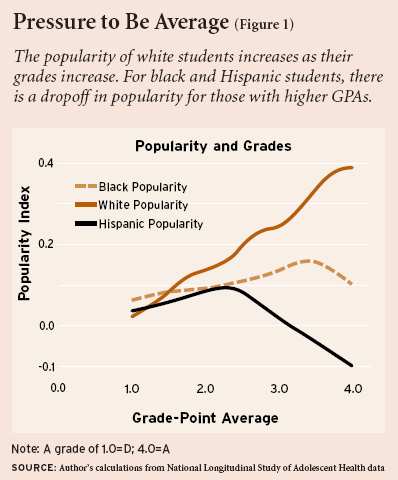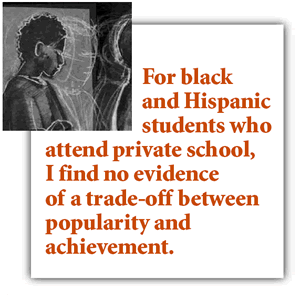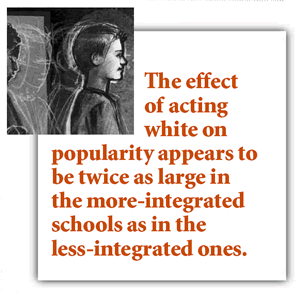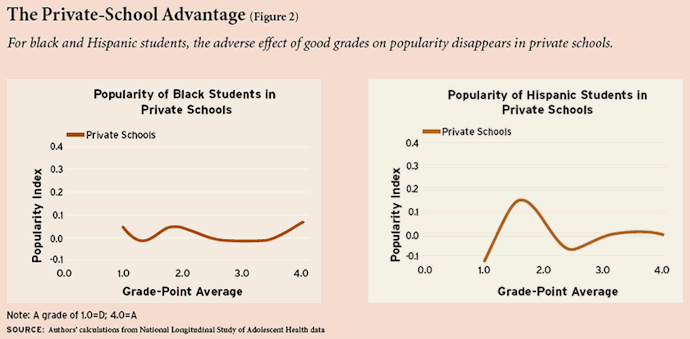
Go into any inner-city neighborhood, and folks will tell you that government alone can’t teach kids to learn.They know that parents have to parent, that children can’t achieve unless we raise their expectations and turn off the television sets and eradicate the slander that says a black youth with a book is acting white.” —Barack Obama, Keynote Address, Democratic National Convention, 2004
by Roland Fryer
Acting white was once a label used by scholars, writing in obscure journals, to characterize academically inclined, but allegedly snobbish, minority students who were shunned by their peers.
Now that it has entered the national consciousness—perhaps even its conscience—the term has become a slippery, contentious phrase that is used to refer to a variety of unsavory social practices and attitudes and whose meaning is open to many interpretations, especially as to who is the perpetrator, who the victim.
I cannot, in the research presented here, disentangle all the elements in the dispute, but I can sort out some of its thicker threads. I can also be precise about what I mean by acting white: a set of social interactions in which minority adolescents who get good grades in school enjoy less social popularity than white students who do well academically.
My analysis confirms that acting white is a vexing reality within a subset of American schools. It does not allow me to say whose fault this is, the studious youngster or others in his peer group. But I do find that the way schools are structured affects the incidence of the acting-white phenomenon. The evidence indicates that the social disease, whatever its cause, is most prevalent in racially integrated public schools. It’s less of a problem in the private sector and in predominantly black public schools.
With findings as potentially controversial as these, one wants to be sure that they rest on a solid base. In this regard, I am fortunate that the National Longitudinal Study of Adolescent Health (Adhealth) provides information on the friendship patterns of a nationally representative sample of more than 90,000 students, from 175 schools in 80 communities, who entered grades 7 through 12 in the 1994 school year. With this database, it is possible to move beyond both the more narrowly focused ethnographic studies and the potentially misleading national studies based on self-reported indicators of popularity that have so far guided the discussion of acting white.
 The Meaning of the Phrase
The Meaning of the Phrase
Though not all scholars define acting white in precisely the same way, most definitions include a reference to situations where some minority adolescents ridicule their minority peers for engaging in behaviors perceived to be characteristic of whites. For example, when psychologist Angela Neal-Barnett in 1999 asked some focus-group students to identify acting-white behavior, they listed actions that ranged from speaking standard English and enrolling in an Advanced Placement or honors class to wearing clothes from the Gap or Abercrombie & Fitch (instead of Tommy Hilfiger or FUBU) and wearing shorts in winter!
Only some of these behaviors have a direct connection to academic engagement. However, as the remarks of Barack Obama, who would later win a seat in the United States Senate, suggest, it is the fact that reading a book or getting good grades might be perceived as acting white that makes the topic a matter of national concern. Indeed, negative peer-group pressure has emerged as a common explanation for the black-white achievement gap, a gap that cannot be explained away by differences in demographic characteristics alone. If minority students today deliberately underachieve in order to avoid social sanctions, that by itself could explain why the academic performance of 17-year-old African Americans, as measured by the National Assessment of Educational Progress (NAEP), has deteriorated since the late 1980s, even while that of nine-year-olds has been improving. It may also help us understand the shortage of minority students in most elite colleges and universities.
Ethnography vs. Statistics
But is this well-publicized aspect of African American peer-culture reality or urban legend? Most ethnographers who examine school life in specific locations present acting white as a pervasive fact of high-school life for black adolescents. But the only two quantitative studies that analyze data from nationally representative samples of high-school students dismiss it altogether as cultural lore. My findings confirm the existence of acting white among blacks as well as among Hispanics, but offer important qualifications about its pervasiveness.
Although they did not coin the term (its origins are obscure), it was an ethnographic study by anthropologists Signithia Fordham and John Ogbu, published in the Urban Journal in 1986, that did the most to bring it to the attention of their fellow academics. Their “Capitol High,” a pseudonym for a predominantly black high school in a low-income area of Washington, D.C., had what the researchers said was an “oppositional culture” in which black youth dismissed academically oriented behavior as “white.”
In the late 1990s, Harvard University economist, Ron Ferguson, found much the same thing in quite another setting, an upper-class suburb of Cleveland, Ohio, called Shaker Heights. Although that city had been integrated for generations, large racial disparities in achievement persisted. When Ferguson detected an anti-intellectual culture among blacks in the local high school, Shaker Heights became virtually synonymous with the problem of acting white.
Fordham and Ogbu traced the roots of the “oppositional culture” to institutionalized racism within American society, which they contend led blacks to define academic achievement as the prerogative of whites and to invest themselves instead in alternative pursuits. Other observers, however, place the blame for acting white squarely on the shoulders of blacks. The Manhattan Institute’s John McWhorter, for example, contrasts African American youth culture with that of immigrants (including blacks from the Caribbean and Africa) who “haven’t sabotaged themselves through victimology.” These two theories, the former blaming acting white on a racist society, the latter on self-imposed cultural sabotage, have emerged as the predominant explanations for acting white among American blacks.
In fact, however, shunning the academic is hardly the exclusive prerogative of contemporary African American culture. James Coleman’s classic work The Adolescent Society, published in 1955, identified members of the sports teams and cheerleaders, not those on the honor role, as the most popular students in public schools. (See an excerpt from Coleman’s original Harvard Education Review article.) The former bring honor to the entire school, reasoned the University of Chicago sociologist; the latter, only to themselves. Since Coleman, ethnographers have found similar tensions between self-advancement and community integration. Indeed, variants on acting white have been spotted by ethnographers among the Buraku outcasts of Japan, Italian immigrants in Boston’s West End, the Maori of New Zealand, and the British working class, among others.
Even so, the question remains whether the tension that Coleman identified is more severe in some cultural contexts than others. On this topic, two sets of scholars weighed in with quantitative studies based on nationally representative surveys. Writing in 1998 in the American Sociological Review, James Ainsworth-Darnell of Georgia State University and Douglas Downey of Ohio State University reported that anti-intellectualism is no more severe a problem among black or Hispanic adolescents than it is among whites. Meanwhile, in a 1997 study, economists Phillip Cook of Duke and Jens Ludwig of Georgetown found that high-achieving black students are, if anything, even more popular relative to low-achieving peers than are high-achieving whites.
Of course, it is possible that the social rewards for achievement do not vary among ethnic groups in the United States. But both studies, each of which is based on data from the National Educational Longitudinal Study (NELS), have a common shortcoming in that they depend solely on a self-reported measure of personal popularity. The NELS contains a question that asks if the student “thinks others see him/her as popular.” The answer choices are: very, somewhat, or not at all. Unfortunately, when students are asked to judge their own popularity, they can be expected to provide a rosier scenario than is warranted.
 New Data and Methods
New Data and Methods
Fortunately, the Adhealth data I used in this study allow me to measure popularity in a more subtle way. All the students surveyed were asked to list their closest male and female friends, up to five of each sex. I first counted how often each student’s name appeared on peers’ lists. I then adjusted these raw counts to reflect the fact that some friends count more than others. The more frequently a peer is listed by others, the more weight I assign to showing up on his or her list.
The advantage of this research strategy is that one never has to ask a student about his or her own popularity. Students’ natural tendency to brag, in this case by listing popular students as their friends, only gives us a more accurate picture of the school’s most desirable friends. Students listed as a friend by many peers who are themselves popular, rise to the top of the social hierarchy. Those who are listed by only a few peers, who in turn have few admitted friends, stand out as the marginal members of the community.
Armed with an objective measure of social status, I could examine more systematically whether or not the ethnographers were correct in identifying a distinctive acting-white phenomenon within African American communities. Do high-achieving minority students have fewer, less-popular friends than lower-achieving peers? How does this compare with the experience of white students?
I first report my findings using a measure of each student’s popularity within his or her own ethnic group, as that is the most direct test of the acting-white hypothesis. But as I explain below, I obtain the same set of results when I analyze the data without regard to the friends’ ethnicity.
I measure student achievement with a composite of grade-point average (GPA) based on student self-reports of their most recent grades in English, math, history/social studies, and science. When comparing the popularity of high- and low-achieving students, I compare students only with students who attend the same school, ensuring that the results are not skewed by unmeasured characteristics of specific schools. Even then, I take into account a number of factors, measured by the survey, that could affect popularity differently for students from different ethnic backgrounds. These factors include parental education and occupation and participation in various school activities, such as varsity sports, student government, and cheerleading.
Finally, to subject my findings to the strongest possible test, I adjust students’ popularity to reflect variation in self-reported effort in school. Recall that some types of acting-white theory say that students are penalized only for trying hard, not for achievement per se. The bright kid who can’t help but get good grades is not subjected to scorn. It’s the plodding rate busters with books constantly in their faces who are annoying. By adjusting for the effort students are putting into their studies, I do my best to separate the social consequences of achievement from those of effort to achieve.
 New Evidence of Acting White
New Evidence of Acting White
Even after taking into account many factors that affect student popularity, evidence remains strong that acting white is a genuine issue and worthy of Senator Obama’s attention. Figure 1, which plots the underlying relationship between popularity and achievement, shows large differences among whites, blacks, and Hispanics. At low GPAs, there is little difference among ethnic groups in the relationship between grades and popularity, and high-achieving blacks are actually more popular within their ethnic group than high-achieving whites are within theirs. But when a student achieves a 2.5 GPA (an even mix of Bs and Cs), clear differences start to emerge.
As grades improve beyond this level, Hispanic students lose popularity at an alarming rate. Although African Americans with GPAs as high as 3.5 continue to have more friends than those with lower grades, the rate of increase is no longer as great as among white students.
The experience of black and white students diverges as GPAs climb above 3.5. As the GPAs of black students increase beyond this level, they tend to have fewer and fewer friends. A black student with a 4.0 has, on average, 1.5 fewer friends of the same ethnicity than a white student with the same GPA. Put differently, a black student with straight As is no more popular than a black student with a 2.9 GPA, but high-achieving whites are at the top of the popularity pyramid.
My findings with respect to Hispanics are even more discouraging. A Hispanic student with a 4.0 GPA is the least popular of all Hispanic students, and Hispanic-white differences among high achievers are the most extreme.
The social costs of a high GPA are most pronounced for adolescent males. Popularity begins to decrease at lower GPAs for young black men than young black women (3.25 GPA compared with a 3.5), and the rate at which males lose friends after this point is far greater. As a result, black male high achievers have notably fewer friends than do female ones. I observe a similar pattern among Hispanics, with males beginning to lose friends at lower GPAs and at a faster clip, though the male-female differences are not statistically significant.
Potential Objections
Could high-achieving minority students be more socially isolated simply because there are so few of them? The number of high-achieving minority students in the average school is fewer than the number of high-achieving white students. To see whether this disparity could explain my findings, I adjusted the data to eliminate the effect of differences in the number of students at each school with similar GPAs. This adjustment, however, did little to temper the effect of acting white.
It might also be hypothesized that high-achieving minority students are able to cultivate friendships with students of other ethnic groups. If so, I should obtain quite different results when I examine popularity among students of all ethnic groups. While one finds some evidence that high-achieving students are more popular among students of other ethnicities, the increment is not enough to offset the decline in popularity within their own ethnic group—a predictable finding, given that black and white students have only, on average, one friend of another ethnicity, and Hispanics just one and a half.
Indeed, when minority students reach the very highest levels of academic performance, even the number of cross-ethnic friendships declines. Black and Hispanic students with a GPA above 3.5 actually have fewer cross-ethnic friendships than those with lower grades, a finding that seems particularly troubling.
Finally, I examined whether high-achieving blacks and Hispanics can shield themselves from the costs of acting white by taking up extracurricular activities. There are many opportunities in schools for students to self-select into activities, including organized sports, cheerleading, student government, band, and the National Honor Society, that should put them in contact with students with similar interests.
Unfortunately, when I look separately at minority students who participate in each of these activities, I find only one within which ethnic differences are eliminated: the National Honor Society. Among students involved in every other activity, new friends made outside the classroom do not make up for the social penalties imposed for acting white.
A Private-School Edge
The patterns described thus far essentially characterize social dynamics of public-school students, who constitute 94 percent of the students in the Adhealth sample. For the small percentage of black and Hispanic students who attend private school, however, I find no evidence of a trade-off between popularity and achievement (see Figure 2). Surprisingly, white private-school students with the highest grades are not as popular as their lower-achieving peers. The most-popular white students in private schools have a GPA of roughly 2.0, a C average.
These data may help to explain one of the more puzzling findings in the research on the relative advantages of public and private schools. Most studies of academic achievement find little or no benefit of attending a private school for white students, but quite large benefits for African Americans. It may be that blacks attending private schools have quite a different peer group.
The Segregated School: Is It an Advantage?
I also find that acting white is unique to those schools where black students comprise less than 80 percent of the student population. In predominantly black schools, I find no evidence at all that getting good grades adversely affects students’ popularity.
But perhaps this changes when school desegregation leads to cross-ethnic friendships within the school. To see how the degree of internal integration within a school affects acting-white patterns, I calculated the difference from what I would expect in the total number of cross-ethnic friends in a school based on the ethnic make-up of the student body. Schools with a greater percentage of cross-ethnic friendships than expected are considered to be internally integrated. I divide schools into two groups of equal size: those with higher and lower degrees of internal integration.
Unfortunately, internal integration only aggravates the problem. Blacks in less-integrated schools (places with fewer than expected cross-ethnic friendships) encounter less of a trade-off between popularity and achievement. In fact, the effect of acting white on popularity appears to be twice as large in the more-integrated (racially mixed) schools as in the less-integrated ones. Among the highest achievers (3.5 GPA or higher), the differences are even more stark, with the effect of acting white almost five times as great in settings with more cross-ethnic friendships than expected. Black males in such schools fare the worst, penalized seven times as harshly as my estimate of the average effect of acting white on all black students!
This finding, along with the fact that I find no evidence of acting white in predominantly black schools, adds to the evidence of a “Shaker Heights” syndrome, in which racially integrated settings only reinforce pressures to toe the ethnic line.
In Search of an Answer
That acting white is more prevalent in schools with more interethnic contact hardly passes the test of political correctness. It nonetheless provides a clue to what is going on. Anthropologists have long observed that social groups seek to preserve their identity, an activity that accelerates when threats to internal cohesion intensify. Within a group, the more successful individuals can be expected to enhance the power and cohesion of the group as long as their loyalty is not in question. But if the group risks losing its most successful members to outsiders, then the group will seek to prevent the outflow. Cohesive yet threatened groups—the Amish, for example—are known for limiting their children’s education for fear that too much contact with the outside world risks the community’s survival.
In an achievement-based society where two groups, for historical reasons, achieve at noticeably different levels, the group with lower achievement levels is at risk of losing its most successful members, especially in situations where successful individuals have opportunities to establish contacts with outsiders. Over the long run, the group faces the danger that its most successful members will no longer identify with its interests, and group identity will itself erode. To forestall such erosion, groups may try to reinforce their identity by penalizing members for differentiating themselves from the group. The penalties are likely to increase whenever the threats to group cohesion intensify.
Applying this model of behavior to minority and white students yields two important predictions: A positive relationship between academic achievement and peer-group acceptance (popularity) will erode and turn negative, whenever the group as a whole has lower levels of achievement. And that erosion will be exacerbated in contexts that foster more interethnic contact. This, of course, is exactly what I found with regard to acting white.
Understanding acting white in this way places the concept within a broader conceptual framework that transcends specific cultural contexts and lifts the topic beyond pointless ideological exchanges. There is necessarily a trade-off between doing well and rejection by your peers when you come from a traditionally low-achieving group, especially when that group comes into contact with more outsiders.
Alternative Explanations
Such a conceptualization is preferable to both of the two theories that have so far dominated discussions of acting white: the notion of oppositional culture and the allegation of cultural self-sabotage.
The oppositional culture theory, developed by Fordham and Ogbu in the wake of their experiences at “Capitol High,” accounts for the observed differences between blacks and whites as follows: (1) white people provide blacks with inferior schooling and treat them differently in school; (2) by imposing a job ceiling, white people fail to reward blacks adequately for their academic achievement in adult life; and (3) black Americans develop coping devices which, in turn, further limit their striving for academic success. Fordham and Ogbu suggest the problem arose partly because white Americans traditionally refused to acknowledge that black Americans were capable of intellectual achievement and partly because black Americans subsequently began to doubt their own intellectual ability, began to define academic success as white people’s prerogative, and began to discourage their peers, perhaps unconsciously, from emulating white people in striving for academic success.
However plausible it sounds, the oppositional culture theory cannot explain why the acting-white problem is greatest in integrated settings. If Fordham and Ogbu were correct, the social sanctions for acting white should be most severe in places like the segregated school, where opportunities are most limited. The results of my studies, of course, point in precisely the opposite direction.
The notion that acting white is simply attributable to self-sabotage is even less persuasive. According to its proponents, black and Hispanic cultures are dysfunctional, punishing successful members of their group rather than rewarding their success. That theory is more a judgment than an explanation. A universal, it cannot explain the kinds of variations from one school setting to another that are so apparent in the data I have explored.
The Need for New Identities
How important are these social pressures? Although that story has yet to be fully told, in my view, the prevalence of acting white in schools with racially mixed student bodies suggests that social pressures could go a long way toward explaining the large racial and ethnic gaps in SAT scores, the underperformance of minorities in suburban schools, and the lack of adequate representation of blacks and Hispanics in elite colleges and universities.
Minority communities in the United States have yet to generate a large cadre of high achievers, a situation as discouraging as the high incarceration rates among minorities who never finish high school. In fact, the two patterns may be linked. As long as distressed communities provide minorities with their identities, the social costs of breaking free will remain high. To increase the likelihood that more can do so, society must find ways for these high achievers to thrive in settings where adverse social pressures are less intense. The integrated school, by itself, apparently cannot achieve that end.
Roland G. Fryer is assistant professor of economics, Harvard University and a faculty research fellow, the National Bureau of Economic Research.

